Early Identification of Olive Oil Defects throughout Shelf Life
Abstract
:1. Introduction
2. Materials and Methods
2.1. Samples and Experimental Design
2.2. Storage Conditions
2.3. Physicochemical and Organoleptic Classification
2.4. Analytical Procedure
3. Results and Discussion
3.1. Monitoring of VOCs
| Compound nr. | Compound a | LRIcalc b | LRIlit c | % Arbequina | % Community |
|---|---|---|---|---|---|
| Aldehydes | |||||
| 19 | Hexanal | 1067 | 1083 | 1.81 ± 0.04 | 1.12 ± 0.01 |
| 24 | 2-Pentenal (isomer) | 1108 | 0.06 ± 0 | 0 ± 0 | |
| 25 | 3-Hexenal (isomer) | 1120 | 0 ± 0 | 0.25 ± 0.09 | |
| 33 | Heptanal | 1175 | 1184 | 0.03 ± 0 | 0.06 ± 0 |
| 35 | E-2-Hexenal | 1192 | 1216 | 33.53 ± 0.13 | 2.08 ± 0.16 |
| 42 | Octanal | 1281 | 1289 | 0.01 ± 0 | 0.05 ± 0 |
| 44 | 2-Heptenal (isomer) | 1299 | 0.05 ± 0 | 0.06 ± 0.01 | |
| 51 | 2,4-Hexadienal (isomer) | 1358 | 0 ± 0 | 0.04 ± 0.01 | |
| 52 | 2,4-Hexadienal (isomer) | 1358 | 0 ± 0 | 0 ± 0 | |
| 56 | Nonanal | 1387 | 1391 | 0.21 ± 0.04 | 0.89 ± 0.11 |
| 60 | E,E-2,4-Heptadienal | 1427 | 1495 | 0 ± 0 | 0.1 ± 0.02 |
| 75 | 2-Decenal (isomer) | 1620 | 0 ± 0 | 0.09 ± 0.01 | |
| Alcohols | |||||
| 3 | Isopropyl Alcohol | nc | 927 | 2.49 ± 0.12 | 12.81 ± 0.47 |
| 23 | 2-Pentanol | 1096 | 1119 | 0 ± 0 | 0.18 ± 0.01 |
| 28 | 1-Penten-3-ol (isomer) | 1131 | 0.36 ± 0.01 | 0.11 ± 0 | |
| 34 | Isopentanol | 1178 | 1209 | 0.8 ± 0.01 | 1.31 ± 0.05 |
| 36 | Pentanol | 1220 | 1250 | 0.09 ± 0 | 0.1 ± 0.02 |
| 43 | 2-Penten-1-ol (isomer) | 1284 | 0.63 ± 0.01 | 0.39 ± 0.01 | |
| 47 | Hexanol | 1321 | 1355 | 5.44 ± 0.06 | 3.48 ± 0.04 |
| 48 | E-3-Hexenol | 1329 | 1367 | 0.23 ± 0 | 1.14 ± 0.05 |
| 50 | Z-3-Hexenol | 1347 | 1382 | 4.88 ± 0.01 | 8.63 ± 0.15 |
| 54 | E-2-Hexenol | 1368 | 1405 | 12.49 ± 0.03 | 0.45 ± 0 |
| 55 | Z-2-Hexenol | 1377 | 1416 | 0.07 ± 0 | 0 ± 0 |
| 58 | 1-Octen-3-ol (isomer) | 1399 | 0 ± 0 | 0 ± 0 | |
| 59 | Heptanol | 1403 | 1453 | 0.05 ± 0 | 0 ± 0 |
| 62 | 2-Heptenol (isomer) | 1450 | 0 ± 0 | 0 ± 0 | |
| 64 | Linalool | 1480 | 1547 | 0 ± 0 | 0.04 ± 0 |
| 65 | Octanol | 1506 | 1557 | 0 ± 0 | 0 ± 0 |
| 80 | Benzyl alcohol | 1804 | 1870 | 0.26 ± 0 | 0.08 ± 0 |
| 81 | Phenylethyl Alcohol | 1841 | 1906 | 0.49 ± 0.01 | 0.22 ± 0.01 |
| Carboxylic acids | |||||
| 57 | Acetic acid | 1392 | 1449 | 20.03 ± 0.27 | 24.21 ± 0.54 |
| 61 | Formic acid | 1445 | 1503 | 0 ± 0 | 0 ± 0 |
| 63 | Propanoic acid | 1479 | 1535 | 0.09 ± 0 | 0 ± 0 |
| 66 | Isobutyric acid | 1509 | 1570 | 0.02 ± 0 | 0 ± 0 |
| 71 | Butanoic acid | 1564 | 1625 | 1.08 ± 0.13 | 0 ± 0 |
| 76 | Pentanoic acid | 1671 | 1622 | 0.03 ± 0 | 0 ± 0 |
| 79 | Hexanoic acid | 1773 | 1846 | 0.15 ± 0 | 0.05 ± 0 |
| 83 | 2-Hexenoic acid (isomer) | 1887 | 0.26 ± 0.01 | 0 ± 0 | |
| 84 | Octanoic acid | 1979 | 2060 | 0 ± 0 | 0.05 ± 0 |
| 87 | Nonanoic acid | 2083 | 2171 | 0 ± 0 | 0 ± 0 |
| Esters | |||||
| 1 | Methyl acetate | nc | 810 | 0.18 ± 0 | 0.65 ± 0.02 |
| 2 | Ethyl Acetate | nc | 880 | 1.24 ± 0.03 | 5.26 ± 0.39 |
| 8 | Ethyl isobutyrate | nc | 961 | 0 ± 0 | 0.04 ± 0 |
| 9 | Methyl butyrate | nc | 982 | 0.03 ± 0 | 0.03 ± 0 |
| 14 | Ethyl butyrate | 1035 | 1035 | 0.32 ± 0 | 0.33 ± 0.03 |
| 17 | Ethyl 2-methylbutyrate | 1062 | 1051 | 0 ± 0 | 0.32 ± 0.02 |
| 18 | Butyl acetate | 1066 | 1074 | 0.02 ± 0 | 0.06 ± 0 |
| 20 | Ethyl isovalerate | 1074 | 1068 | 0 ± 0 | 0.04 ± 0.01 |
| 38 | Ethyl hexanoate | 1239 | 1233 | 0 ± 0 | 0.07 ± 0.01 |
| 41 | Hexyl acetate | 1268 | 1272 | 0 ± 0 | 0 ± 0 |
| 45 | 3-Hexenyl Acetate (isomer) | 1304 | 5.58 ± 0.17 | 10.89 ± 0.47 | |
| 72 | Butyrolactone | 1566 | 1632 | 0 ± 0 | 0.88 ± 0.75 |
| 73 | Methyl benzoate | 1576 | 1612 | 0.04 ± 0 | 0.03 ± 0 |
| Hydrocarbons | |||||
| 4 | Unknown hydrocarbon | nc | 0.95 ± 0.01 | 2.67 ± 0.22 | |
| 12 | Toluene | 1022 | 1042 | 0.12 ± 0 | 0 ± 0 |
| 15 | Ethyl octadiene (isomer) | 1039 | 0.12 ± 0 | 0 ± 0 | |
| 16 | Ethyl octadiene (isomer) | 1040 | 0 ± 0 | 0.04 ± 0.02 | |
| 21 | Ethyl octadiene (isomer) | 1081 | 0.74 ± 0.02 | 0.32 ± 0.02 | |
| 22 | Ethyl octadiene (isomer) | 1092 | 0.59 ± 0.02 | 0.25 ± 0.02 | |
| 26 | Unknown alkane | 1122 | 0.13 ± 0.01 | 0.52 ± 0.06 | |
| 27 | p-xylene | 1130 | 1138 | 0.03 ± 0 | 0.14 ± 0.04 |
| 29 | Ethyl octadiene (isomer) | 1142 | 0.3 ± 0.01 | 0.11 ± 0.01 | |
| 30 | Ethyl octadiene (isomer) | 1147 | 0.79 ± 0.03 | 0.28 ± 0.01 | |
| 31 | o-Xylene | 1169 | 1186 | 0.04 ± 0 | 0.11 ± 0.01 |
| 37 | Styrene | 1215 | 1261 | 0 ± 0 | 0 ± 0 |
| 49 | Unknown alkene | 1342 | 0.29 ± 0.02 | 4.23 ± 0.12 | |
| 68 | Hexadecane | 1600 | 1600 | 0.06 ± 0 | 0.13 ± 0.04 |
| 74 | Unknown alkane | 1628 | 0.07 ± 0.01 | 0.14 ± 0.07 | |
| Ethers | |||||
| 10 | Hexyl methyl ether | nc | 941 | 0 ± 0 | 6.13 ± 0.34 |
| 13 | 3-Hexen-1-ol, methyl ether | 1025 | 980 | 0 ± 0 | 1.54 ± 0.15 |
| 53 | Benzyl methyl ether | 1363 | 1394 | 0 ± 0 | 0.32 ± 0.01 |
| Terpenes | |||||
| 40 | β-Ocimene | 1258 | 1250 | 0.56 ± 0.26 | 1.52 ± 0.17 |
| 69 | Unknown sesquiterpene | 1549 | 0 ± 0 | 0.14 ± 0.02 | |
| 70 | Unknown sesquiterpene | 1558 | 0.05 ± 0 | 1.04 ± 0.08 | |
| 77 | Unknown sesquiterpene | 1750 | 0 ± 0 | 0.13 ± 0 | |
| 78 | α-Farnesene | 1762 | 1746 | 0.15 ± 0.01 | 0.95 ± 0 |
| Ketones | |||||
| 6 | Pentanone (isomer) | nc | 0 ± 0 | 0.17 ± 0 | |
| 7 | Pentanone (isomer) | nc | 0.72 ± 0 | 0.81 ± 0.08 | |
| 11 | 1-Penten-3-one | nc | 1019 | 0.27 ± 0.01 | 0 ± 0 |
| 32 | 2-Heptanone | 1171 | 1182 | 0 ± 0 | 0 ± 0 |
| 46 | Sulcatone | 1316 | 1338 | 0 ± 0 | 0.03 ± 0 |
| Others | |||||
| 5 | 2-Ethylfuran | nc | 950 | 0 ± 0 | 0 ± 0 |
| 39 | Acetoin | 1242 | 1284 | 0.07 ± 0 | 0.24 ± 0.02 |
| 67 | Dimethyl Sulfoxide | 1523 | 1573 | 0.6 ± 0.05 | 0.83 ± 0.24 |
| 82 | Unknown | 1886 | 0.12 ± 0.02 | 0.19 ± 0.01 | |
| 85 | Dimethyl salicylate | 1995 | 2061 | 0 ± 0 | 0.06 ± 0.02 |
| 86 | Phenol, 3-ethyl- | 2083 | 2171 | 0.18 ± 0.05 | 0.35 ± 0.07 |
3.2. Evolution of VOCs over the Storage Time
3.3. Monitoring the Ratio of E-2-Hexenal to Acetic Acid
3.4. Confirmation of the E-2-Hexenal/Acetic Acid Ratio
4. Conclusions
Author Contributions
Funding
Data Availability Statement
Acknowledgments
Conflicts of Interest
References
- Ferro-Luzzi, A.; Cialfa, E.; Leclercq, C.; Toti, E. The Mediterranean Diet Revisited. Focus on Fruit and Vegetables. Int. J. Food Sci. Nutr. 1994, 45, 291–300. [Google Scholar] [CrossRef]
- Tur, J.A.; Ngo de la Cruz, J.; Ribas, L. Olive Oil and the Mediterranean Diet: Beyond the Rhetoric. Eur. J. Clin. Nutr. 2003, 57, S2–S7. [Google Scholar] [CrossRef] [PubMed]
- Foscolou, A.; Critselis, E.; Panagiotakos, D. Olive Oil Consumption and Human Health: A Narrative Review. Maturitas 2018, 118, 60–66. [Google Scholar] [CrossRef]
- Bendini, A.; Cerretani, L.; Carrasco-Pancorbo, A.; Gómez-Caravaca, A.M.; Segura-Carretero, A.; Fernández-Gutiérrez, A.; Lercker, G. Phenolic Molecules in Virgin Olive Oils: A Survey of Their Sensory Properties, Health Effects, Antioxidant Activity and Analytical Methods. An Overview of the Last Decade Alessandra. Molecules 2007, 12, 1679–1719. [Google Scholar] [CrossRef] [PubMed]
- Boskou, D. Olive Oil: Chemistry and Technology, 2nd ed.; Taylor & Francis: Abingdon, UK, 2006. [Google Scholar] [CrossRef]
- Servili, M.; Taticchi, A.; Esposto, S.; Urbani, S.; Selvaggini, R.; Montedoro, G.F. Effect of Olive Stoning on the Volatile and Phenolic Composition of Virgin Olive Oil. J. Agric. Food Chem. 2007, 55, 7028–7035. [Google Scholar] [CrossRef] [PubMed]
- Servili, M.; Esposto, S.; Fabiani, R.; Urbani, S.; Taticchi, A.; Mariucci, F.; Selvaggini, R.; Montedoro, G.F. Phenolic Compounds in Olive Oil: Antioxidant, Health and Organoleptic Activities According to Their Chemical Structure. Inflammopharmacology 2009, 17, 76–84. [Google Scholar] [CrossRef] [PubMed]
- Favati, F.; Condelli, N.; Galgano, F.; Caruso, M.C. Extra Virgin Olive Oil Bitterness Evaluation by Sensory and Chemical Analyses. Food Chem. 2013, 139, 949–954. [Google Scholar] [CrossRef]
- Pedan, V.; Popp, M.; Rohn, S.; Nyfeler, M.; Bongartz, A. Characterization of Phenolic Compounds and Their Contribution to Sensory Properties of Olive Oil. Molecules 2019, 24, 2041. [Google Scholar] [CrossRef] [PubMed]
- Angerosa, F. Sensory Quality of Olive Oils. In Handbook of Olive Oil; Springer: Berlin/Heidelberg, Germany, 2000; pp. 355–392. [Google Scholar] [CrossRef]
- Angerosa, F.; Campestre, C. Sensory Quality: Methodologies and Applications. In Handbook of Olive Oil: Analysis and Properties; Springer: Berlin/Heidelberg, Germany, 2013; pp. 523–560. [Google Scholar] [CrossRef]
- Kalua, C.; Allen, M.; Bedgood, D., Jr.; Bishop, A.; Prenzler, P.; Robards, K. Rapid Communication Olive Oil Volatile Compounds, Flavour Development and Quality: A Critical Review. Food Chem. 2007, 100, 273–286. [Google Scholar] [CrossRef]
- Morales, M.T.; Aparicio, R.; Rios, J.J. Dynamic Headspace Gas Chromatographic Method for Determining Volatiles in Virgin Olive Oil. J. Chromatogr. A 1994, 668, 455–462. [Google Scholar] [CrossRef]
- Angerosa, F.; Servili, M.; Selvaggini, R.; Taticchi, A.; Esposto, S.; Montedoro, G. Volatile Compounds in Virgin Olive Oil: Occurrence and Their Relationship with the Quality. J. Chromatogr. A 2004, 1054, 17–31. [Google Scholar] [CrossRef] [PubMed]
- Vick, B.A.; Zimmerman, D.C. Oxidative Systems for Modification of Fatty Acids: The Lipoxygenase Pathway. In Lipids: Structure and Function; Academic Press: Cambridge, MA, USA, 1987; pp. 53–90. [Google Scholar] [CrossRef]
- Morales, M.T.; Tsimidou, M. The Role of Volatile Compounds and Polyphenols in Olive Oil Sensory Quality. In Handbook of Olive Oil; Springer: Berlin/Heidelberg, Germany, 2000; pp. 393–458. [Google Scholar] [CrossRef]
- Campestre, C.; Angelini, G.; Gasbarri, C.; Angerosa, F. The Compounds Responsible for the Sensory Profile in Monovarietal Virgin Olive Oils. Molecules 2017, 22, 1833. [Google Scholar] [CrossRef]
- Cecchi, L.; Migliorini, M.; Mulinacci, N. Virgin Olive Oil Volatile Compounds: Composition, Sensory Characteristics, Analytical Approaches, Quality Control, and Authentication. J. Agric. Food Chem. 2021, 69, 2013–2040. [Google Scholar] [CrossRef] [PubMed]
- Venkateshwarlu, G.; Let, M.B.; Meyer, A.S.; Jacobsen, C. Modeling the Sensory Impact of Defined Combinations of Volatile Lipid Oxidation Products on Fishy and Metallic Off-Flavors. J. Agric. Food Chem. 2004, 52, 1635–1641. [Google Scholar] [CrossRef] [PubMed]
- Salas, J.J.; Sánchez, C.; García-González, D.L.; Aparicio, R. Impact of the Suppression of Lipoxygenase and Hydroperoxide Lyase on the Quality of the Green Odor in Green Leaves. J. Agric. Food Chem. 2005, 53, 1648–1655. [Google Scholar] [CrossRef] [PubMed]
- Angerosa, F. Influence of Volatile Compounds on Virgin Olive Oil Quality Evaluated by Analytical Approaches and Sensor Panels. Eur. J. Lipid Sci. Technol. 2002, 104, 639–660. [Google Scholar] [CrossRef]
- Baccouri, O.; Bendini, A.; Cerretani, L.; Guerfel, M.; Baccouri, B.; Lercker, G.; Zarrouk, M.; Daoud Ben Miled, D. Comparative Study on Volatile Compounds from Tunisian and Sicilian Monovarietal Virgin Olive Oils. Food Chem. 2008, 111, 322–328. [Google Scholar] [CrossRef] [PubMed]
- Psomiadou, E.; Tsimidou, M. Stability of Virgin Olive Oil. 1. Autoxidation Studies. J. Agric. Food Chem. 2002, 50, 716–721. [Google Scholar] [CrossRef] [PubMed]
- Choe, E.; Min, D.B. Mechanisms and Factors for Edible Oil Oxidation. Compr. Rev. Food Sci. Food Saf. 2006, 5, 169–186. [Google Scholar] [CrossRef]
- Reboredo-Rodríguez, P.; González-Barreiro, C.; Cancho-Grande, B.; Simal-Gándara, J. Dynamic Headspace/GC–MS to Control the Aroma Fingerprint of Extra-Virgin Olive Oil from the Same and Different Olive Varieties. Food Control 2012, 25, 684–695. [Google Scholar] [CrossRef]
- Serrano, A.; De la Rosa, R.; Sánchez-Ortiz, A.; Cano, J.; Pérez, A.G.; Sanz, C.; Arias-Calderón, R.; Velasco, L.; León, L. Chemical Components Influencing Oxidative Stability and Sensorial Properties of Extra Virgin Olive Oil and Effect of Genotype and Location on Their Expression. LWT 2021, 136, 110257. [Google Scholar] [CrossRef]
- Benincasa, C.; De Nino, A.; Lombardo, N.; Perri, E.; Sindona, G.; Tagarelli, A. Assay of Aroma Active Components of Virgin Olive Oils from Southern Italian Regions by SPME-GC/Ion Trap Mass Spectrometry. J. Agric. Food Chem. 2003, 51, 733–741. [Google Scholar] [CrossRef] [PubMed]
- Procida, G.; Cichelli, A.; Lagazio, C.; Conte, L.S. Relationships between Volatile Compounds and Sensory Characteristics in Virgin Olive Oil by Analytical and Chemometric Approaches. J. Sci. Food Agric. 2016, 96, 311–318. [Google Scholar] [CrossRef] [PubMed]
- Sensory Analysis of Olive Oil: Method for the Organoleptic Assessment of Virgin Olive Oil. International Olive Council. Available online: https://www.internationaloliveoil.org/wp-content/uploads/2019/11/COI-T20-Doc.-15-REV-10-2018-Eng.pdf (accessed on 19 May 2024).
- Angerosa, F.; Lanza, B.; D’Alessandro, N.; Marsilio, V.; Cumitini, S. Olive Oil Off-Odour Compounds Produced by Aspergillus and Penicillium. Acta Hortic. 1999, 474, 695–699. [Google Scholar] [CrossRef]
- Aparicio, R.; Rocha, S.M.; Delgadillo, I.; Morales, M.T. Detection of Rancid Defect in Virgin Olive Oil by the Electronic Nose. J. Agric. Food Chem. 2000, 48, 853–860. [Google Scholar] [CrossRef]
- Angerosa, F.; Lanza, B.; Marsilio, V. Biogenesis of «fusty» Defect in Virgin Olive Oils. Grasas Aceites 1996, 47, 142–150. [Google Scholar] [CrossRef]
- Morales, M.T.; Luna, G.; Aparicio, R. Comparative Study of Virgin Olive Oil Sensory Defects. Food Chem. 2005, 91, 293–301. [Google Scholar] [CrossRef]
- Jimenez-Lopez, C.; Carpena, M.; Lourenço-Lopes, C.; Gallardo-Gomez, M.; Lorenzo, J.M.; Barba, F.J.; Prieto, M.A.; Simal-Gandara, J. Bioactive Compounds and Quality of Extra Virgin Olive Oil. Foods 2020, 9, 1014. [Google Scholar] [CrossRef]
- Kanavouras, A.; Hernandez-Munoz, P.; Coutelieris, F.A. Packaging of Olive Oil: Quality Issues and Shelf Life Predictions. Food Rev. Int. 2006, 22, 381–404. [Google Scholar] [CrossRef]
- Di Serio, M.G.; Giansante, L.; Di Loreto, G.; Di Giacinto, L. Shelf Life of Extra-Virgin Olive Oils: First Efforts toward a Prediction Model. J. Food Process. Preserv. 2018, 42, e13663. [Google Scholar] [CrossRef]
- Commission Implementing Regulation (EU) 2022/2105 of 29 July 2022 Laying down Rules on Conformity Checks of Marketing Standards for Olive Oil and Methods of Analysis of the Characteristics of Olive Oil. Off. J. Eur. Union. Available online: https://eur-lex.europa.eu/legal-content/EN/TXT/PDF/?uri=CELEX:32022R2105 (accessed on 19 May 2024).
- Commission Regulation (EC) No 1989/2003 of 6 November 2003 Regulation (EEC) No 2568/91 on the Characteristics of Olive Oil and Olive-Pomace Oil and on the Relevant Methods of Analysis. Off. J. Eur. Union. Available online: https://eur-lex.europa.eu/LexUriServ/LexUriServ.do?uri=OJ%3AL:2003:295:0057:0077%3AEN%3APDF (accessed on 19 May 2024).
- Commission Delegated Regulation (EU) 2022/2104 of 29 July 2022 Supplementing Regulation (EU) No 1308/2013 of the European Parliament and of the Council as Regards Marketing Standards for Olive Oil, and Repealing Commission Regulation (EEC) No 2568/91 and Commission Implementing Regulation (EU) No 29/2012. Off. J. Eur. Union. Available online: https://eur-lex.europa.eu/legal-content/EN/TXT/PDF/?uri=CELEX:32022R2104 (accessed on 19 May 2024).
- Aparicio, R.; Morales, M.T.; García-González, D.L. Towards New Analyses of Aroma and Volatiles to Understand Sensory Perception of Olive Oil. Eur. J. Lipid Sci. Technol. 2012, 114, 1114–1125. [Google Scholar] [CrossRef]
- Sensory Analysis of Olive Oil. Standard Guide for the Selection, Training and Quality Control of Virgin Olive Oil Tasters. Qualifications of Tasters, Panel Leaders and Trainers. International Olive Council. Available online: https://www.internationaloliveoil.org/wp-content/uploads/2022/10/COI-T.20-Doc-14-REV-7-2021-EN.pdf (accessed on 19 May 2024).
- Romero, I.; García-González, D.L.; Aparicio-Ruiz, R.; Morales, M.T. Validation of SPME–GCMS Method for the Analysis of Virgin Olive Oil Volatiles Responsible for Sensory Defects. Talanta 2015, 134, 394–401. [Google Scholar] [CrossRef] [PubMed]
- Morales, M.T.; Aparicio-Ruiz, R.; Aparicio, R. Chromatographic Methodologies: Compounds for Olive Oil Odor Issues. In Handbook of Olive Oil: Analysis and Properties; Springer: Berlin/Heidelberg, Germany, 2013; pp. 261–309. [Google Scholar] [CrossRef]
- Flamini, G. Headspace Analyses in Valuable and Functional Foods: Application of SPME in the Quality Control and Characterization of Olive Oils. Curr. Anal. Chem. 2007, 3, 149–159. [Google Scholar] [CrossRef]
- Oliver-Pozo, C.; Aparicio-Ruiz, R.; Romero, I.; García-González, D.L. Analysis of Volatile Markers for Virgin Olive Oil Aroma Defects by SPME-GC/FID: Possible Sources of Incorrect Data. J. Agric. Food Chem. 2015, 63, 10477–10483. [Google Scholar] [CrossRef]
- Martins, N.; Jiménez-Morillo, N.T.; Freitas, F.; Garcia, R.; Gomes da Silva, M.; Cabrita, M.J. Revisiting 3D van Krevelen Diagrams as a Tool for the Visualization of Volatile Profile of Varietal Olive Oils from Alentejo Region, Portugal. Talanta 2020, 207, 120276. [Google Scholar] [CrossRef]
- ben Hammouda, I.; Freitas, F.; Ammar, S.; Da Silva, M.D.R.G.; Bouaziz, M. Comparison and Characterization of Volatile Compounds as Markers of Oils Stability during Frying by HS–SPME-GC/MS and Chemometric Analysis. J. Chromatogr. B 2017, 1068–1069, 322–334. [Google Scholar] [CrossRef] [PubMed]
- Van Den Dool, H.A.N.D.; Kratz, P.D. A Generalization of the Retention Index System Including Linear Temperature Programmed Gas—Liquid Partition Chromatography. J. Chromatogr. A 1963, 11, 463–471. [Google Scholar] [CrossRef]
- Saracino, F.; Brinco, J.; Gago, D.; Gomes da Silva, M.; Boavida Ferreira, R.; Ricardo-Da-silva, J.; Chagas, R.; Ferreira, L.M. DCMC as a Promising Alternative to Bentonite in White Wine Stabilization. Impact on Protein Stability and Wine Aromatic Fraction. Molecules 2021, 26, 6188. [Google Scholar] [CrossRef] [PubMed]
- Da Silva, M.D.G.; Freitas, A.M.C.; Cabrita, M.J.B.; Garcia, R.; da Silva, M.D.R.G.; Freitas, A.M.C.; Cabrita, M.J.B.; Garcia, R. Olive Oil Composition: Volatile Compounds. In Olive Oil—Constituents, Quality, Health Properties and Bioconversions; IntechOpen: Rijeka, Croatia, 2012. [Google Scholar] [CrossRef]
- Linstrom, P.J.; Mallard, W.G. The NIST Chemistry WebBook: A Chemical Data Resource on the Internet. J. Chem. Eng. Data 2001, 46, 1059–1063. [Google Scholar] [CrossRef]
- Garcia-Oliveira, P.; Jimenez-Lopez, C.; Lourenço-Lopes, C.; Chamorro, F.; Pereira, A.G.; Carrera-Casais, A.; Fraga-Corral, M.; Carpena, M.; Simal-Gandara, J.; Prieto, M.A. Evolution of Flavors in Extra Virgin Olive Oil Shelf-Life. Antioxidants 2021, 10, 368. [Google Scholar] [CrossRef]
- Kiritsakis, A.K. Flavor Components of Olive Oil—A Review. JAOCS J. Am. Oil Chem. Soc. 1998, 75, 673–681. [Google Scholar] [CrossRef]
- Angerosa, F.; Mostallino, R.; Basti, C.; Vito, R. Virgin Olive Oil Odour Notes: Their Relationships with Volatile Compounds from the Lipoxygenase Pathway and Secoiridoid Compounds. Food Chem. 2000, 68, 283–287. [Google Scholar] [CrossRef]
- Tena, N.; Lazzez, A.; Aparicio-Ruiz, R.; García-González, D.L. Volatile Compounds Characterizing Tunisian Chemlali and Chétoui Virgin Olive Oils. J. Agric. Food Chem. 2007, 55, 7852–7858. [Google Scholar] [CrossRef]
- Reiners, J.; Grosch, W. Odorants of Virgin Olive Oils with Different Flavor Profiles. J. Agric. Food Chem. 1998, 46, 2754–2763. [Google Scholar] [CrossRef]
- Esti, M.; Contini, M.; Moneta, E.; Sinesio, F. Phenolics Compounds and Temporal Perception of Bitterness and Pungency in Extra-Virgin Olive Oils: Changes Occurring throughout Storage. Food Chem. 2009, 113, 1095–1100. [Google Scholar] [CrossRef]
- Angerosa, F.; Camera, L.; D’Alessandro, N.; Mellerio, G. Characterization of Seven New Hydrocarbon Compounds Present in the Aroma of Virgin Olive Oils. J. Agric. Food Chem. 1998, 46, 648–653. [Google Scholar] [CrossRef] [PubMed]
- Neugebauer, A.; Schieberle, P.; Granvogl, M. Characterization of the Key Odorants Causing the Musty and Fusty/Muddy Sediment Off-Flavors in Olive Oils. J. Agric. Food Chem. 2021, 69, 14878–14892. [Google Scholar] [CrossRef] [PubMed]
- Zhu, H.; Wang, S.C.; Shoemaker, C.F. Volatile Constituents in Sensory Defective Virgin Olive Oils. Flavour Fragr. J. 2016, 31, 22–30. [Google Scholar] [CrossRef]
- Manai, H.; Mahjoub-Haddada, F.; Oueslati, I.; Daoud, D.; Zarrouk, M. Characterization of Monovarietal Virgin Olive Oils from Six Crossing Varieties. Sci. Hortic. 2008, 115, 252–260. [Google Scholar] [CrossRef]
- Ilyasoglu, H.; Ozcelik, B.; Van Hoed, V.; Verhe, R. Cultivar Characterization of Aegean Olive Oils with Respect to Their Volatile Compounds. Sci. Hortic. 2011, 129, 279–282. [Google Scholar] [CrossRef]
- Angerosa, F.; Basti, C.; Vito, R. Virgin Olive Oil Volatile Compounds from Lipoxygenase Pathway and Characterization of Some Italian Cultivars. J. Agric. Food Chem. 1999, 47, 836–839. [Google Scholar] [CrossRef]
- Dhifi, W.; Angerosa, F.; Serraiocco, A.; Oumar, I.; Hamrouni, I.; Marzouk, B. Virgin Olive Oil Aroma: Characterization of Some Tunisian Cultivars. Food Chem. 2005, 93, 697–701. [Google Scholar] [CrossRef]

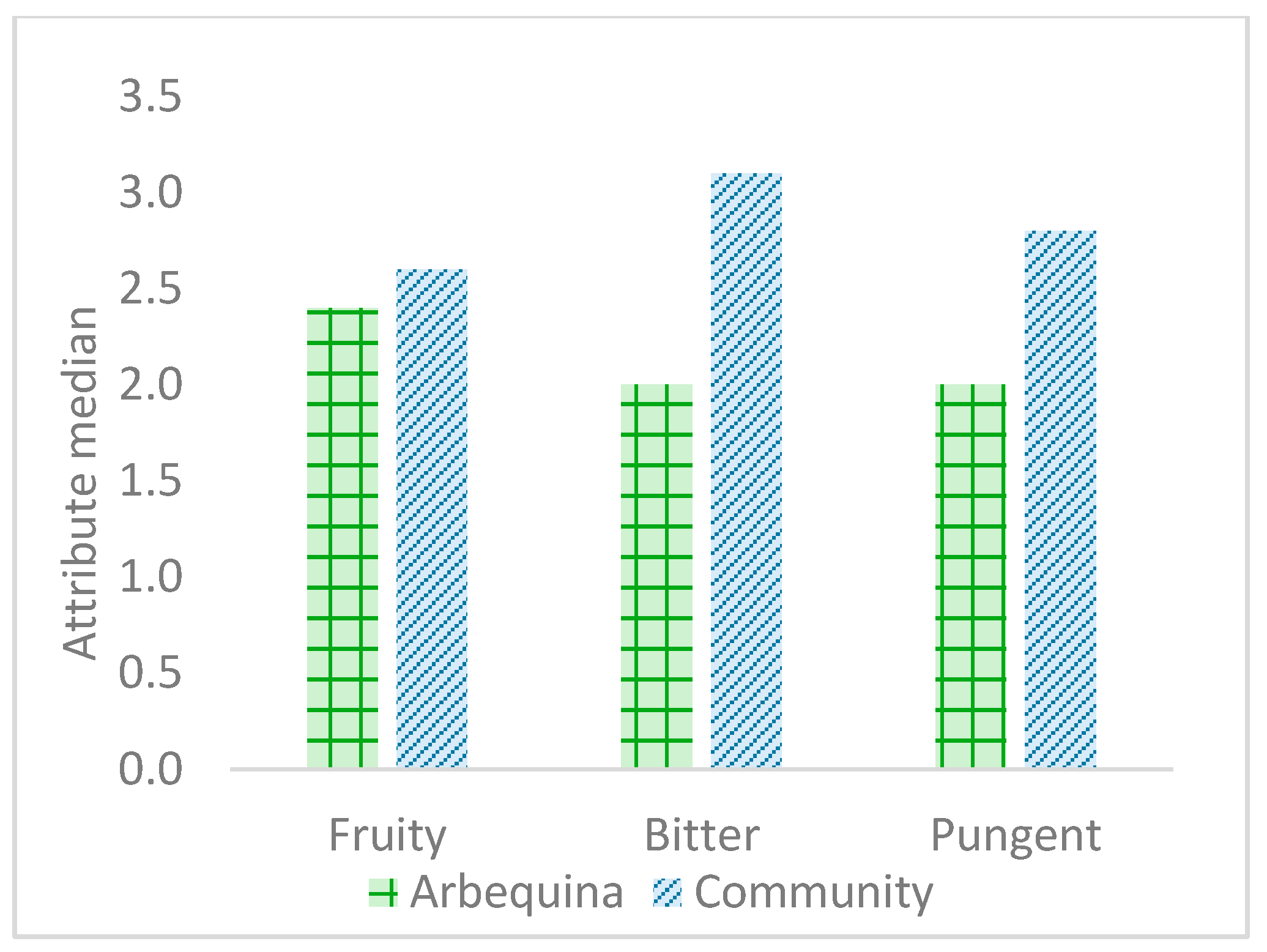
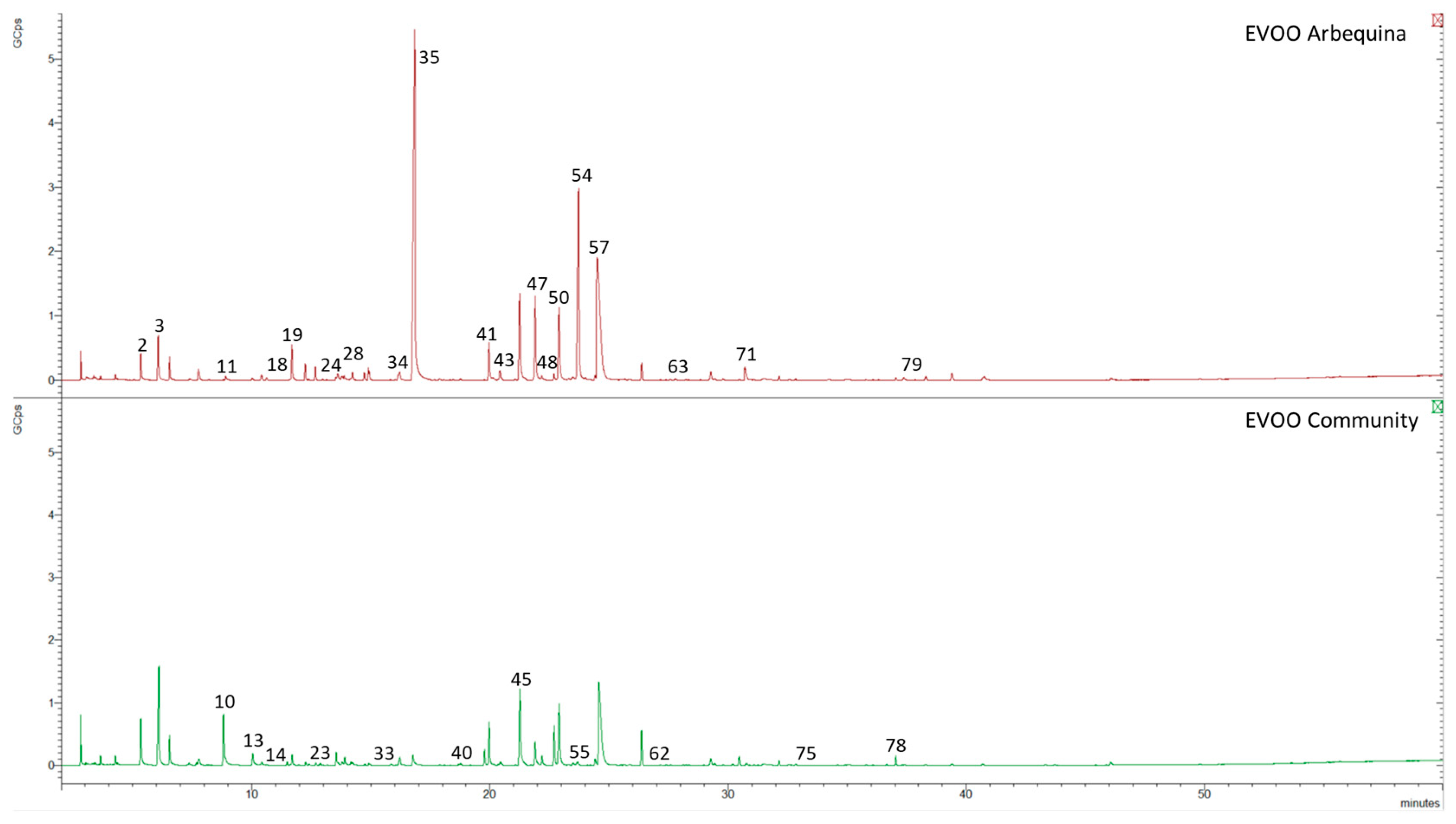

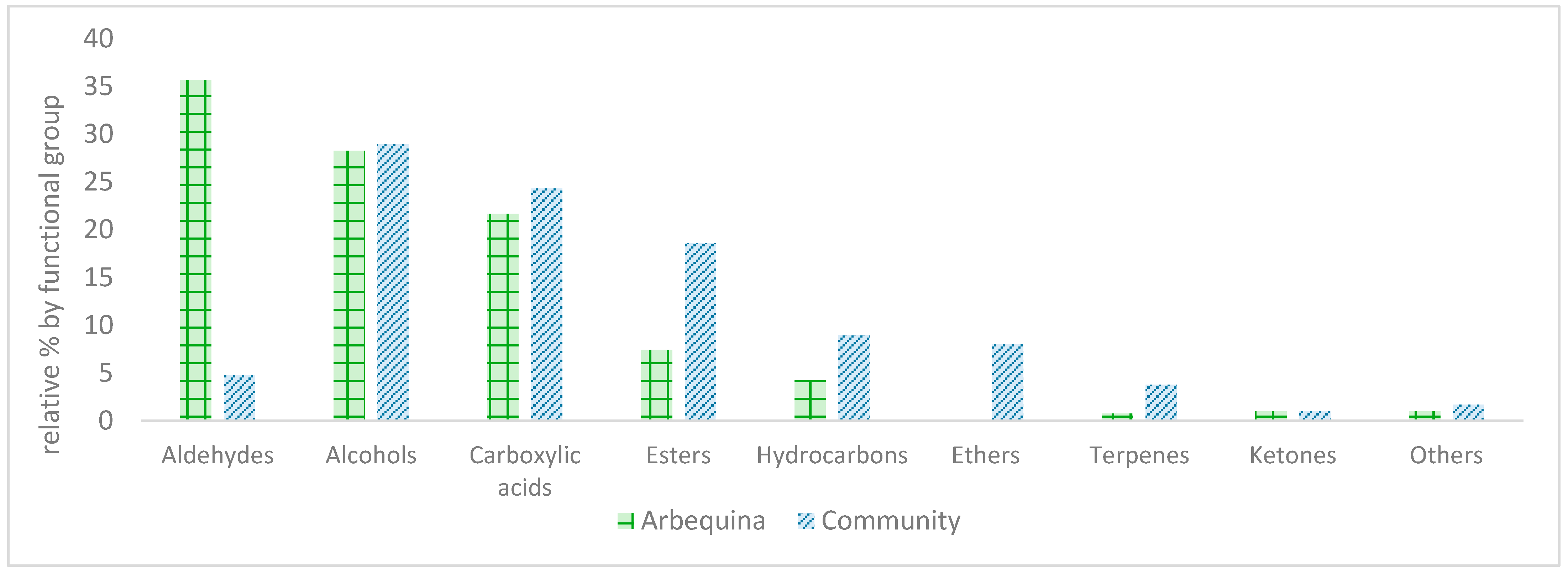

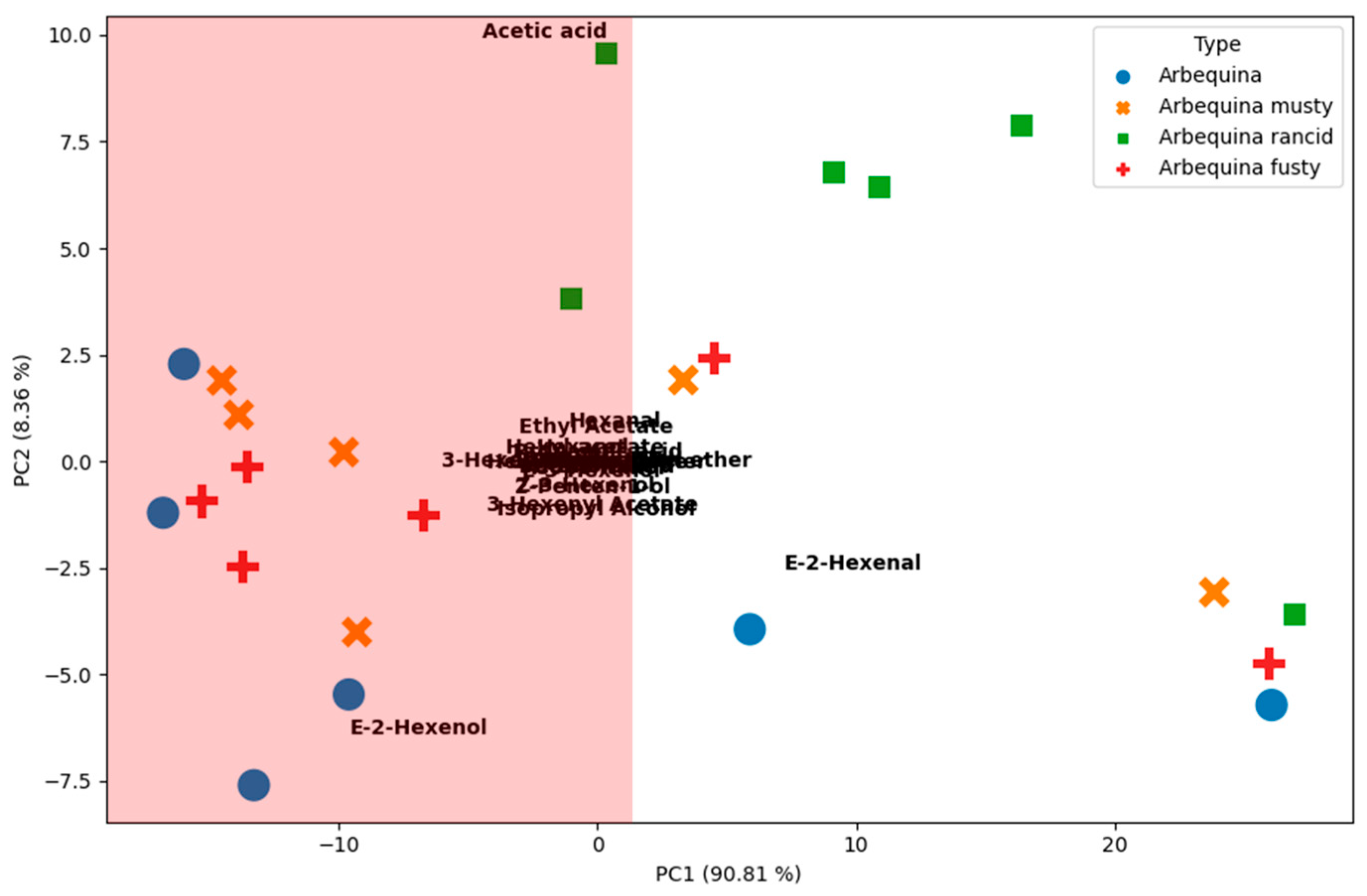
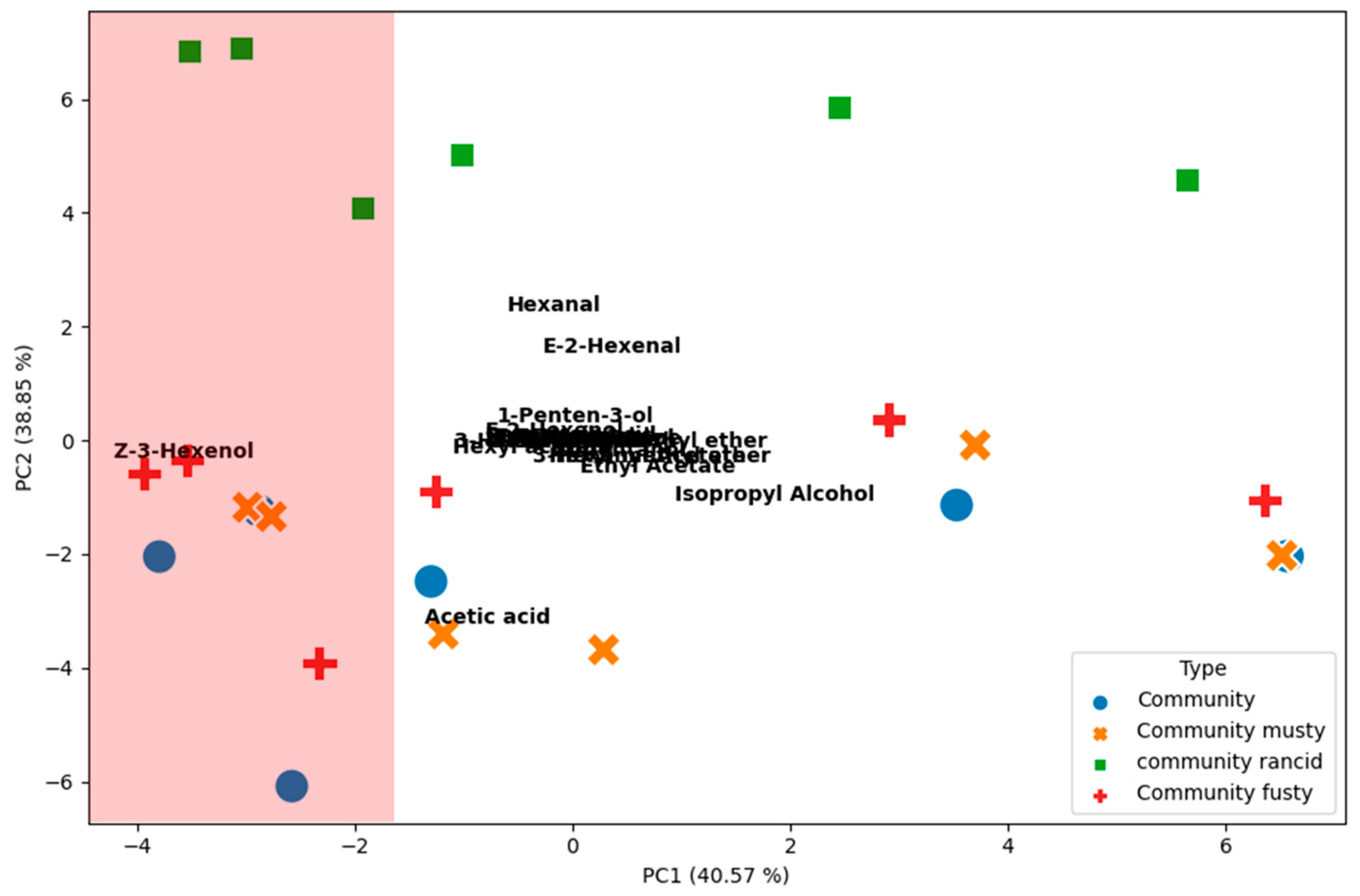


| Description of Samples | ||
|---|---|---|
| Monitoring of VOCs | Ar | Monovarietal EVOO from the Arbequina olives |
| Ar musty | Arbequina EVOO doped with 5% (v/v) of disqualified olive oil with evident musty defect | |
| Ar rancid | Arbequina EVOO doped with 5% (v/v) of disqualified olive oil with evident rancidity defect | |
| Ar fusty | Arbequina EVOO doped with 5% (v/v) of disqualified olive oil with evident fusty defect | |
| Co | Community EVOO from local producers | |
| Co musty | Community EVOO doped with 5% (v/v) of disqualified olive oil with evident musty defect | |
| Co rancid | Community EVOO doped with 5% (v/v) of disqualified olive oil with evident rancidity defect | |
| Co fusty | Community EVOO doped with 5% (v/v) of disqualified olive oil with evident fusty defect | |
| Monitoring of the E-2-hexenal/Acetic Acid | 0% Def | Monovarietal EVOO from the Arbequina olives |
| 20% Def | Arbequina EVOO doped with 20% (v/v) of disqualified Arbequina olive oil (OO) | |
| 30% Def | Arbequina EVOO doped with 30% (v/v) of disqualified Arbequina OO | |
| 40% Def | Arbequina EVOO doped with 40% (v/v) of disqualified Arbequina OO | |
| 50% Def | Arbequina EVOO doped with 50% (v/v) of disqualified Arbequina OO | |
| 60% Def | Arbequina EVOO doped with 60% (v/v) of disqualified Arbequina OO | |
| 70% Def | Arbequina EVOO doped with 70% (v/v) of disqualified Arbequina OO | |
| 80% Def | Arbequina EVOO doped with 80% (v/v) of disqualified Arbequina OO | |
| 100% Def | Disqualified Arbequina OO | |
| Confirmation of the E-2-hexenal/Acetic Acid | PiR | Irrigation Picual EVOO |
| Arb a | Arbequina EVOO | |
| PiD | Dryland Picual EVOO | |
| Arb b | Arbequina EVOO | |
| Hoj | Hojiblanca EVOO | |
| Hoj x | Disqualified Hojiblanca OO | |
| Arb x | Disqualified Arbequina OO | |
| PiD x | Disqualified Dryland Picual OO | |
| PiR x | Disqualified Irrigation Picual OO |
| Compound No. | Compound Name |
|---|---|
| 2 | Ethyl Acetate |
| 3 | Isopropyl Alcohol |
| 10 | Hexyl methyl ether |
| 11 | 1-Penten-3-one |
| 13 | 3-Hexen-1-ol, methyl ether |
| 14 | Ethyl butyrate |
| 18 | Butyl acetate |
| 19 | Hexanal |
| 23 | 2-Pentanol |
| 24 | 2-Pentenal |
| 28 | 1-Penten-3-ol |
| 33 | Heptanal |
| 34 | Isopentanol |
| 35 | E-2-Hexenal |
| 40 | β-Ocimene |
| 41 | Hexyl acetate |
| 43 | 2-Penten-1-ol |
| 45 | 3-Hexenyl Acetate |
| 47 | Hexanol |
| 48 | E-3-Hexenol |
| 50 | Z-3-Hexenol |
| 54 | E-2-Hexenol |
| 55 | Z-2-Hexenol |
| 57 | Acetic acid |
| 62 | 2-Heptenol |
| 63 | Propanoic acid |
| 71 | Butanoic acid |
| 75 | Z-2-Decenal |
| 78 | α-Farnesene |
| 79 | Hexanoic acid |
Disclaimer/Publisher’s Note: The statements, opinions and data contained in all publications are solely those of the individual author(s) and contributor(s) and not of MDPI and/or the editor(s). MDPI and/or the editor(s) disclaim responsibility for any injury to people or property resulting from any ideas, methods, instructions or products referred to in the content. |
© 2024 by the authors. Licensee MDPI, Basel, Switzerland. This article is an open access article distributed under the terms and conditions of the Creative Commons Attribution (CC BY) license (https://creativecommons.org/licenses/by/4.0/).
Share and Cite
Freitas, F.; Cabrita, M.J.; da Silva, M.G. Early Identification of Olive Oil Defects throughout Shelf Life. Separations 2024, 11, 167. https://doi.org/10.3390/separations11060167
Freitas F, Cabrita MJ, da Silva MG. Early Identification of Olive Oil Defects throughout Shelf Life. Separations. 2024; 11(6):167. https://doi.org/10.3390/separations11060167
Chicago/Turabian StyleFreitas, Flávia, Maria João Cabrita, and Marco Gomes da Silva. 2024. "Early Identification of Olive Oil Defects throughout Shelf Life" Separations 11, no. 6: 167. https://doi.org/10.3390/separations11060167





